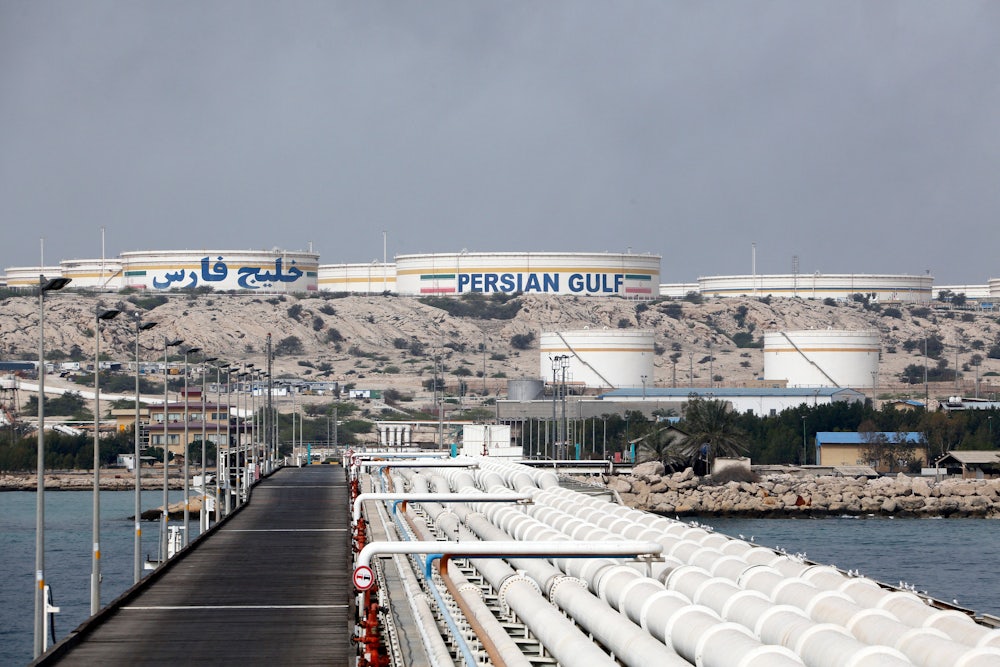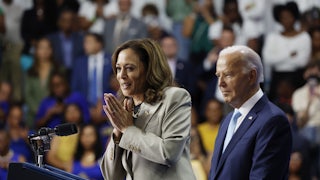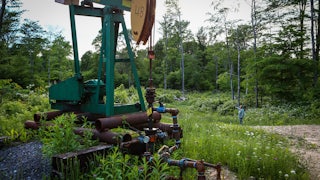An ongoing investigation from The Washington Post reports that U.S. government sanctions are now “targeting a third of all nations with some kind of financial penalty on people, properties or organizations.” As reporters Jeff Stein, Federica Cocco, and Peter Whoriskey note in a new installment in that series published last week, the sanctions boom has spawned a lucrative cottage industry for D.C. lobbyists. Foreign spending on sanctions-related lobbying, they write, “has surged from roughly $6 million in 2014 to at least $31 million in 2022, the last year for which complete records are available.”
A seemingly unrelated report from the U.N. Environment Program finds that the world is currently on track to warm by between 2.6 and 3.1 degrees Celsius by 2100, far more than the goal of “well below two degrees” (3.6 degrees Fahrenheit) outlined in the Paris Climate Agreement. Greenhouse gas emissions rose to record levels last year—up 1.3 percent over 2022 levels—as countries fail to make progress toward the modest emissions reductions targets they’ve set for themselves.
With the world sailing toward hellish levels of global warming, the fact that a third of it is under some form of sanction from the United States—the world’s largest historical emitter of planet-heating greenhouse gases—should be cause for concern. Sanctions can impose environmental threats in their own right, limiting targeted countries’ ability to respond to climate disasters and invest in low-carbon development. The Post’s investigation notes concern from current and former U.S. officials that the massive uptick in sanctions could undermine possibilities for the kind of global cooperation desperately needed to deal with the climate crisis. Moreover, if sanctions can be seen as an extension of American economic statecraft—alongside tariffs and trade agreements—their increasingly bipartisan popularity may well threaten the climate goals the White House claims that Bidenomics aims to meet.
“Undergoing the green transition requires two things: technology and financing,” says Esfandyar Batmanghelidj, CEO of the Bourse & Bazaar Foundation, an economic think tank. “Broad sanctions regimes, like those in place on Russia and Iran, are expressly designed to reduce access to technology.” These sanctions are meant to reduce government revenues and close off options for foreign investments and loans. “So while the sanctions may not directly target a country’s ability to install solar panels, build wind turbines, or adopt electric vehicles, these critical steps for the green transition become more difficult,” Batmanghelidj told me.
Sanctions accordingly offer major oil-producing states like Russia and Iran, especially, an unintended source of leverage, Batmanghelidj argues. They provide “ways to externalize the costs of sanctions,” he says, meaning that countries that can’t invest in greener development might double down on fossil fuels that help make the planet hotter for everyone. A recent paper in the journal Policy Studies finds that, by 2028, sanctions on Iran are expected to drive up carbon emissions by 12.5 to 30 percent above what they would be otherwise. Researchers attribute that to sanctions’ limits on Iran’s access to technology, services, and expertise; their blockage of international aid; and amplification of the natural resource intensity of Iran’s economy, e.g., the amount of fossil fuels used across economic sectors. “Prior research has typically identified a positive correlation between economic growth and CO2 emissions. In contrast, our findings indicate that during the period of lifted sanctions,” the study’s authors write, “heightened economic growth coincides with a reduction in energy-related CO2 emissions, attributed to improved energy intensity.”
Sanctions further hamper countries’ ability to respond to climate-fueled disasters. Referencing U.S. and EU policymakers’ move to enable Syria’s access to humanitarian aid and reconstruction efforts after a devastating 7.8 magnitude earthquake there in 2023, Batmanghelidj asked “whether we should be considering the climate emergency in similar terms, and redesigning sanctions policies to carve out space for climate mitigation and adaptation efforts.”
Such a move would seem to stand at odds with how the U.S. currently approaches the global economy, which generally prioritizes U.S. allies as sites of clean energy investment. In a speech at the Brookings Institution last week, national security adviser Jake Sullivan elaborated on the White House’s “high fence, small yard” strategy: working with trade partners to grow their share of the pie in strategic growth industries such as semiconductors and green energy technologies, and mounting targeted protections against “non-market practices, labor and environment abuses, and economic coercion” that affect those industries—namely initiated by China. That’s in line with official White House policy, such as imposing 100 percent tariffs on Chinese cars and extending Trump’s tariffs on other goods from China, all the while encouraging the EU to adopt similar policies.
Former National Economic Council director Brian Deese—a key architect of the Inflation Reduction Act, now advising the Harris campaign—has written along similar lines that climate change both is the world’s most pressing challenge and “will be the largest capital formation event in human history. And it presents the United States with a chance to lead.” He goes on to outline a Clean Energy Marshall Plan premised on building new markets for U.S-made green tech in developing countries and “crafting a global coalition” to retaliate against Chinese exports. Such a plan would allow the U.S. to invest in its own manufacturing capacity “while winning greater influence in this new geopolitical landscape.”
It’s worth distinguishing between sanctions and the more conventional industrial policy tools Deese and Sullivan emphasize, such as tariffs and coordinated trade policies. “Those can play an important role in making the national economy and the global economy wealthier overall,” says Jake Werner, acting director of the Quincy Institute’s East Asia Program. “But the Biden approach to these things—more offensive and defensive policies in the economic realm, as part of a total package—are increasing the use of conflict in the global system, working to fragment the global economy and create rival great power blocks.”
Secretary of State Antony Blinken was more explicit still in describing sanctions as a tool for furthering U.S. economic competitiveness, noting in Foreign Affairs earlier this month that America’s “strategic fitness rests in large measure on its economic competitiveness.” After boasting about the U.S. having convinced several European and Asian countries to sever certain economic ties with China and enforce retaliatory measures against its “discretionary tactics,” Blinken wrote that the White House has worked to:
reinvigorate and reimagine the United States’ network of relationships—enabling Washington and its partners to pool their strength in advancing a shared vision for the world and compete vigorously yet responsibly against those seeking to undermine it. Competing vigorously means using all the instruments of U.S. power to advance U.S. interests. It means enhancing the United States’ force posture, military and intelligence capabilities, sanctions and export control tools, and mechanisms for consulting with allies and partners so that the country can credibly deter—and, if necessary, defend against—aggression.
As the U.S. divides up the world into trade partners and enemies, certain countries have lobbied for more favorable treatment. Many of those just happen to be petrostates, including Azerbaijan and the United Arab Emirates. In other cases, U.S.-based companies have lobbied to box out foreign competition. The Washington Post’s investigation found that aluminum producer Alcoa spent $1 million on lobbyists as it pushed for sanctions on Russian aluminum producers; over the last six years, U.S. entities, predominantly companies, have spent $1 billion on lobbying contracts that mention “China” and “sanctions” as specific targets, per Justice Department records, albeit including other goals as well.
Poorer countries have also paid handsome sums to firms in D.C.—including many former lawmakers and White House officials—to lobby for sanctions relief. W. Gyude Moore, a fellow at the Center for Global Development, a Washington-based think tank, told the Post reporters that when a poor African country “hires another Washington lobbyist, that’s money that’s not available for schools, for hospitals.” By extension, sanctions lobbying might well also sap funds for mitigation and adaptation efforts, or disaster recovery.
At a global level, U.S. officials have tended to see climate change primarily as a question of selling stuff: of conquering a map of new export markets and competitors. In reality, low-income countries spending nearly a quarter of their external revenue on debt servicing will be hard-pressed to buy much of anything without the sort of comprehensive debt relief and reforms that the U.S. has been mostly unwilling to back. Piecemeal efforts like the Just Energy Transition Partnerships—to spur clean energy investments in fossil fuel–heavy developing economies—have floundered; the administration’s other fig leaves to climate finance rely either on dubious carbon-offset schemes or borderline fantastical hopes for “mobilizing” hundreds of billions in private-sector investment, hoping Wall Street will find irresistible returns building climate-resilient infrastructure in some of the world’s poorest places.
How much of all this might change under a prospective Harris administration remains to be seen. Beyond taking counsel from Deese, she hasn’t said much about the climate crisis either domestically or globally. A Trump administration would be disastrous on both fronts, albeit working with a similar tool box for economic statecraft. “The Biden administration had a high degree of continuity with the first Trump administration,” Werner argues. From tariffs on China to the weaponization of the U.S. dollar, “they kept everything and built on it: they systemetized it, and they made it more effective. A second Trump administration would take that over, and build on the more robust and systematic foundation that Biden has given them.”








